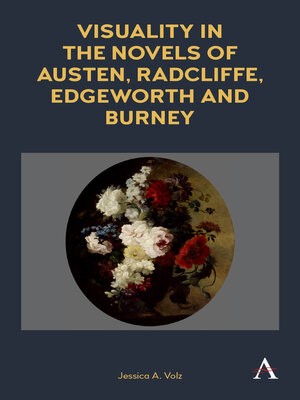Visuality in the Novels of Austen, Radcliffe, Edgeworth and Burney
ebook ∣ Anthem Nineteenth-Century
By Jessica A. Volz

Sign up to save your library
With an OverDrive account, you can save your favorite libraries for at-a-glance information about availability. Find out more about OverDrive accounts.
Find this title in Libby, the library reading app by OverDrive.



Search for a digital library with this title
Title found at these libraries:
| Library Name | Distance |
|---|---|
| Loading... |
Visuality in the Novels of Austen, Radcliffe, Edgeworth and Burney argues that the proliferation of visual codes, metaphors and references to the gaze in women's novels published in Britain between 1778 and 1815 is more significant than scholars have previously acknowledged. The book's innovative survey of the oeuvres of four culturally representative women novelists of the period spanning the Anglo-French War and the Battle of Waterloo reveals the importance of visuality – the continuum linking visual and verbal communication. It provided women novelists with a methodology capable of circumventing the cultural strictures on female expression in a way that concealed resistance within the limits of language. In contexts dominated by 'frustrated utterance', penetrating gazes and the perpetual threat of misinterpretation, Jane Austen, Ann Radcliffe, Maria Edgeworth and Frances Burney used references to the visible and the invisible to comment on emotions, socio-economic conditions and patriarchal abuses. Visuality in the Novels of Austen, Radcliffe, Edgeworth and Burney offers new insights into verbal economy and the gender politics of the era by reassessing expression and perception from a uniquely telling point of view.
|There are many factors that contributed to the proliferation of visual codes, metaphors and references to the gaze in women's fiction of the late-eighteenth and early-nineteenth centuries. 'Visuality in the Novels of Austen, Radcliffe, Edgeworth and Burney' argues that the visual details in women's novels published between 1778 and 1815 are more significant than scholars have previously acknowledged. Its innovative study of the oeuvres of Jane Austen, Ann Radcliffe, Maria Edgeworth and Frances Burney shows that visuality – the continuum linking visual and verbal communication – provided women writers with a methodology capable of circumventing the cultural strictures on female expression in a way that allowed for concealed resistance. Visuality empowered them to convey the actual ways in which women 'should' see and appear in a society in which the reputation was image-based.
The discussion moves from self-referential coordinates exterior to the self in the novels of Austen and Radcliffe to the drama of reflections, fashion and the minutiae of coded self-display in the novels of Edgeworth and Burney. The analysis engages with scholarly critiques drawn from literature, art history, optics, psychology, philosophy and anthropology to assert visuality's multidisciplinary influences and diplomatic potential. The non-chronological structure embraces overlapping themes rather than the illusion of a conclusive departure from the reciprocity between the appearance and the essence.
'Visuality in the Novels of Austen, Radcliffe, Edgeworth and Burney' explores how in fiction and in actuality, women negotiated four scopic forces that determined their 'looks' and manners of looking: the impartial spectator, the male gaze, the public eye and the disenfranchised female gaze. In a society dominated by 'frustrated utterance', penetrating gazes and the perpetual threat of misinterpretation, women novelists used references to the visible and the invisible to comment on emotions, socioeconomic conditions and patriarchal abuses. Austen, Radcliffe, Edgeworth and Burney provide ideal case studies in this regard because they were culturally representative figures who also experimented with and contributed to different approaches to the novel. This book thus offers new insights into verbal economy and the gender politics of the era spanning the Anglo-French War and the Battle of Waterloo by reassessing expression and perception from a uniquely...







